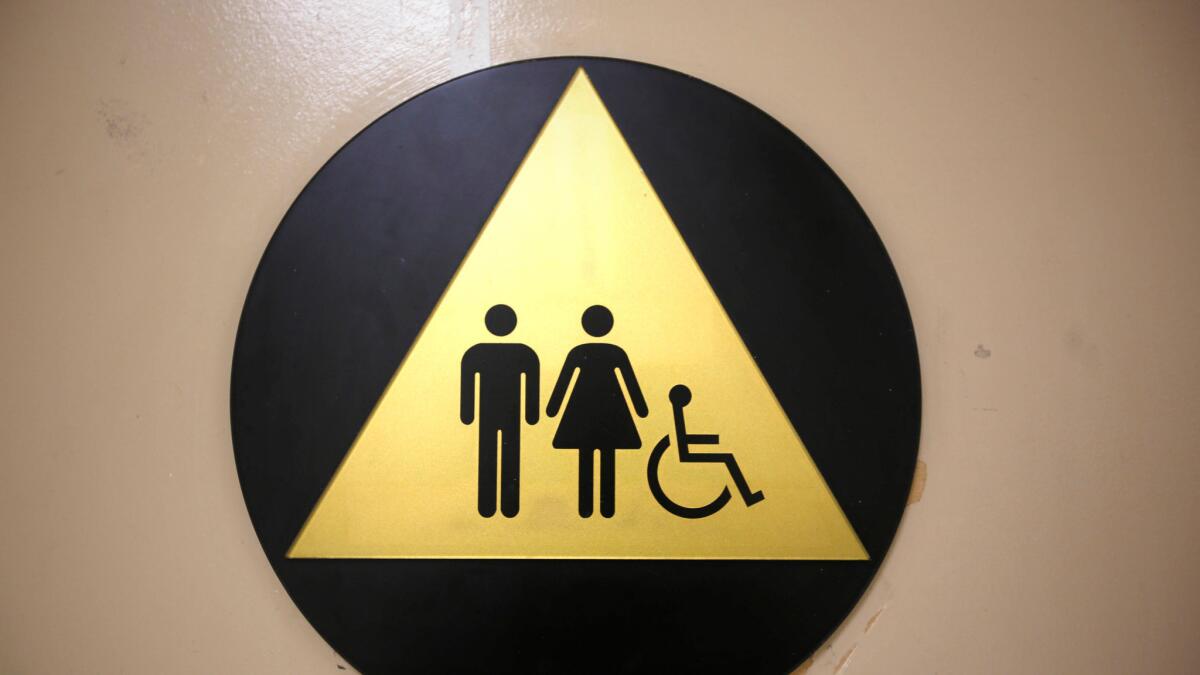What’s at stake in the latest legal battle over bathroom rights for transgender students

- Share via
Reporting from austin, texas — Texas and 11 other states have asked a federal judge to halt an Obama administration directive on bathroom rights for transgender students in U.S. public schools. But no immediate ruling was issued during the Friday hearing — even with the first day of school looming in much of the country. Here’s what you need to know:
What started all this?
The administration told U.S. public schools in May that transgender students must be allowed to use bathrooms and locker rooms consistent with their chosen gender identity.
That announcement came days after the Justice Department sued North Carolina over a state law that requires people to use public bathrooms that correspond with the sex on their birth certificate — which U.S. Atty. Gen. Loretta Lynch had likened to policies of racial segregation. Republicans have argued such laws are common-sense privacy safeguards.
A new school year is about to start. What if districts don’t comply?
Schools were not explicitly told to comply or lose federal funds. But the Obama administration also didn’t rule out that possibility in court documents filed in July, saying recipients of federal education dollars “are clearly on notice” that anti-discrimination policies must be followed.
Texas alone gets roughly $10 billion in federal education funds, and argues along with the 11 other states that they shouldn’t potentially lose money over what they criticize as a “massive social experiment.”
What happened Friday?
U.S. District Judge Reed O’Connor in Fort Worth heard states’ arguments that the Obama administration directive was unconstitutional, on the basis of which they were seeking a preliminary injunction that would temporarily block it — meaning schools wouldn’t have to worry about complying for now.
Federal attorneys countered that there was no basis for the states to sue. O’Connor didn’t rule right away, and exactly when a decision will come is unknown — though it could be coming soon.
What states are involved?
The lawsuit was filed in May by Texas, Alabama, Wisconsin, West Virginia, Tennessee, Oklahoma, Louisiana, Utah and Georgia, and the Republican governors of Maine, Mississippi and Kentucky. Two small school districts in Arizona and Texas, which have fewer than 600 students combined and no transgender persons on their campuses, also joined the effort to prevent the directive from being enforced.
Aren’t there other ongoing legal battles over transgender rights?
Yes. Perhaps most notable was the U.S. Supreme Court ruling this month that a Virginia school board for now can block a transgender male from using the boys’ restroom when school resumes.
How many transgender students might be affected by the school directive?
The number of transgender students in U.S. public schools is unclear, but in June, a team of experts estimated that about 1.4 million adults in the country identify as transgender.
That’s double the estimate from a decade ago, according to demographer Gary Gates, who worked on the survey with other scholars at the Williams Institute, a think tank at the UCLA School of Law that specializes in research on issues affecting lesbians, gays, bisexuals and transgender people.
Weber writes for the Associated Press.
ALSO
Pakistani clerics issue decree on transgender rights under Islamic law
What it’s like to live under North Carolina’s bathroom law if you’re transgender
More to Read
Sign up for Essential California
The most important California stories and recommendations in your inbox every morning.
You may occasionally receive promotional content from the Los Angeles Times.









